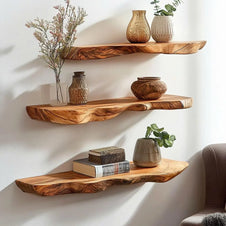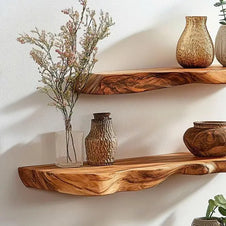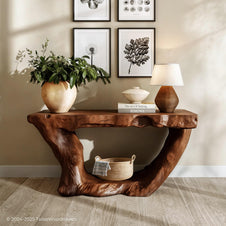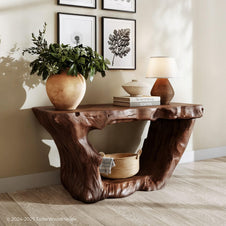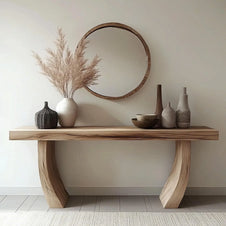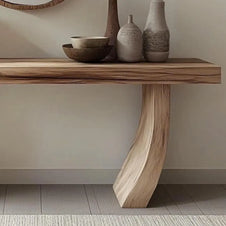Learn how to measure for a corner shelf, especially tree-style shelves. Step-by-step guide for perfect fit, layout, and rustic balance in any room. Includes tips for diagram how to measure for a corner shelf and how to measure a triangle for a corner shelf.
Introduction: Why Measuring Matters for Corner Shelves
Have you ever found the perfect tree bookshelf online, only to realize it doesn't fit your corner once it arrives? You’re not alone. Whether you're designing a minimalist reading nook or creating a rustic focal point, getting the measurements right is essential. Accurately measuring your space ensures your shelf blends beautifully and functions properly. It also saves time, money, and frustration. This guide will help you understand exactly how to measure for a corner shelf, especially if you're planning to incorporate a unique, handcrafted tree-style bookshelf.
1. What Makes Tree Corner Shelves Unique?
Tree bookshelves are unlike traditional wall-mounted shelves or straight freestanding units. They feature a vertical "trunk" and horizontal "branches" that often span two walls of a corner. Their appeal lies in their artistic, nature-inspired structure and functional tiered design. But this organic shape means they require a bit more thoughtful planning. Each "branch" may be a different length or depth, which adds charm—but also complexity—when deciding where and how to place them. Their 3D layout demands careful attention to both vertical height and lateral wall clearance. If you're looking for a visual diagram how to measure for a corner shelf, this article will guide you through that too.

See how these corner tree bookshelf setups get everything just right.
2. What You'll Need to Measure Properly
Before jumping into measurements, gather the tools that will help you capture accurate dimensions:
-
A flexible measuring tape, ideally with both inches and centimeters.
-
A carpenter’s level or bubble level to make sure your base is flat.
-
A pencil or chalk for marking points on the wall.
-
Paper or a sketchpad to record dimensions and create a basic layout.
-
(Optional) Augmented Reality measuring apps, which help visualize the shelf in your space.
Taking time to collect the right tools ensures precision. Trust us—guesstimating with your eyes almost always leads to errors.
3. Step-by-Step: How to Measure for a Corner Shelf
Step 1: Confirm the Corner Angle
Not all corners are perfect 90 degrees. Use a carpenter’s square or an angle finder to confirm. Tree bookshelves, especially those that span two walls, require balanced space on both sides. A corner wider or narrower than 90 degrees might require a custom build or adjustment to branch lengths. Understanding how to measure a triangle for a corner shelf is crucial if your walls don’t form a perfect right angle.
Step 2: Measure Wall Length from the Corner Outward
From the exact corner point, measure at least 24 to 30 inches along each wall. This helps define how wide the branches can be on either side. Mark anything that might interfere, such as power outlets, switches, or trim.
Step 3: Measure Floor-to-Ceiling Height
Most tree bookshelves range from 5 to 7 feet tall. Standard ceiling height in homes is 8 feet, but always measure yours. Leave at least 6 to 12 inches of clearance from the top of the shelf to the ceiling for visual breathing room and accessibility.
Step 4: Account for Baseboards and Molding
Baseboards at the bottom and crown molding at the top can reduce your usable depth. Measure their thickness and subtract it from your shelf depth to ensure a snug fit against the wall.
Step 5: Estimate Branch Tier Depths
This is where tree shelves get fun. You can vary the depth of each tier:
-
Bottom branches: 10–12 inches deep
-
Middle branches: 8–10 inches deep
-
Top branches: 6–8 inches deep
This "step-back" layout creates a natural tree silhouette while providing both style and stability.
4. Think About the Flow Around Your Shelf
Measuring isn’t just about fitting something into a corner—it’s also about ensuring it flows well with the rest of the room. Will people walk by it? Will it block a light source, door, or outlet? Ideally, leave at least 20–24 inches of clearance from walkways or door swings. If your corner is near a frequently used path, opt for narrower branches or position the shelf higher on the wall to reduce interference.

Explore ready-to-style tree bookshelves with clean, balanced setups
5. Common Mistakes When Measuring for Corner Shelves
Even experienced DIYers make mistakes. Here are some to avoid:
-
Ignoring baseboard width and height
-
Measuring only one side of the corner
-
Overlooking uneven floors or sloped ceilings
-
Forgetting to factor in nearby furniture or windows
-
Relying only on product photos without reviewing actual dimensions
Avoiding these common pitfalls helps guarantee a better final installation and a happier design experience.
6. How to Customize Tree Bookshelves to Your Corner
Not all corners are created equal, and not all tree bookshelves are one-size-fits-all. You may need to:
-
Shorten or extend certain branches to fit around windows or doors.
-
Use a taller trunk in rooms with high ceilings.
-
Modify your bracket placement based on wall material (e.g., drywall vs. brick).
-
Adjust the base structure to sit flush over tile or uneven floors.
Customization is where creativity and functionality meet. Tailor your tree bookshelf not just to fit your corner—but to enhance it.
7. Ideal Tree Shelf Dimensions by Room Type
Different rooms demand different setups. Here’s a quick reference guide:
|
Room
|
Shelf Height
|
Branch Depth
|
|
Living Room
|
6–7 feet
|
10–12 inches
|
|
Bedroom
|
5–6 feet
|
8–10 inches
|
|
Entryway
|
4–5 feet
|
6–8 inches
|
|
Home Office
|
6–7 feet
|
8–10 inches
|
Keep in mind the furniture below and around your shelf. For example, leave space above sofas, radiators, or desks.

Measure your space carefully, then explore our custom-fit tree bookshelves designed to match your exact dimensions.
8. How to Sketch Your Corner Shelf Layout
Sketching helps you visualize the shelf before building or buying. On paper:
-
Draw the two intersecting walls.
-
Mark power outlets, switches, and obstructions.
-
Sketch the “trunk” at the corner angle.
-
Add horizontal lines for each tier—label with intended depth.
Digitally, tools like Canva, Figma, or RoomSketcher can help you mock up the corner and simulate scale. If you're a visual learner, consider creating a simple diagram how to measure for a corner shelf to check proportions.
9. Choosing the Right Tree Shelf After Measuring
Once you have dimensions in hand, your next step is to find or request the perfect piece:
-
Check dimensions of pre-made shelves carefully—match to your wall space.
-
Consider custom-made shelves for challenging layouts.
-
Choose hardwoods like walnut or oak for durability.
-
If mounting to drywall, ensure proper anchors and bracket types are used.
 At Tailor Wood Haven, we specialize in custom tree bookshelves crafted to your exact specifications. Browse our tree shelf collection here.
At Tailor Wood Haven, we specialize in custom tree bookshelves crafted to your exact specifications. Browse our tree shelf collection here.
10. Installation Tips Based on Measurements
Mounting your shelf properly is just as critical as measuring it. Use wall studs for better support. For heavier tree shelves:
-
Start installation from the base upwards.
-
Use a level to ensure each tier is even.
-
Space branches at least 10–12 inches apart vertically.
-
Use hidden floating brackets rated for weight capacity.
Install slowly and double-check after each tier. Precision now means less stress later.
This Video shares real-life shelf setups you’ll want to try.
11. Styling Your Corner Tree Shelf
Once installed, styling your shelf brings it to life. Start with:
-
Books and baskets near the trunk (center of gravity)
-
Decorative items like candles and ceramics toward the ends
-
Mix heights and textures for visual interest
-
Leave intentional empty space to avoid clutter
Tree shelves thrive when styled like nature—balanced, varied, and effortless.
Conclusion: Every Great Shelf Begins with a Tape Measure
Measuring may feel technical, but it’s the secret to making your vision real. When you know how to measure for a corner shelf, you open the door to creative possibilities like the beloved tree bookshelf. Whether you need a basic sketch, a diagram how to measure for a corner shelf, or you're trying to understand how to measure a triangle for a corner shelf, it all starts with planning. Every corner can become a cozy reading nook, a showpiece for rustic décor, or a practical storage space. Start with good measurements, and everything else branches out from there—beautifully.

